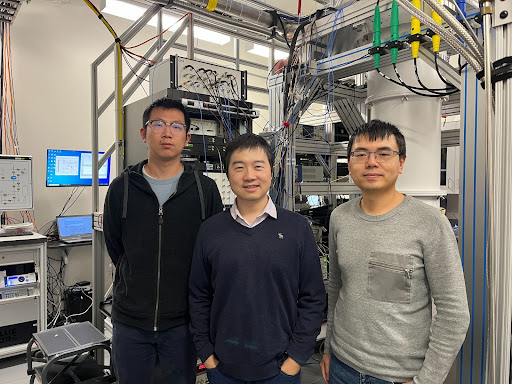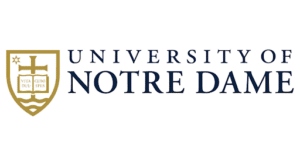Beyond the Microsecond: A Quantum Revolution in Electron Charge Qubits
Electron charge qubits emerge as compelling contenders for solid-state quantum computing due to their inherent simplicity in qubit design, fabrication, control and readout. However, prevailing electron charge qubits, constructed with conventional semiconductors and superconductors, encounter significant challenges from disruptive charge noise, which limits the coherence time to no more than 1 microsecond – until today.
This blog post delves into the intriguing universe of electron charge qubits and showcases the groundbreaking accomplishment led by Dafei Jin, a professor at the University of Notre Dame, together with his team and collaborators at multiple institutions. They have set a new world record for the longest coherence time observed in an electron-on-solid-neon (eNe) qubit, surpassing the performance of all existing charge qubits to date [1]. This achievement not only highlights their exceptional work but also presents an enticing alternative for quantum computing.
The 0.1 Milliseconds Milestone: A Coherence Time Revolution
Qubits serve as the foundational units in quantum computing, and a pivotal metric for assessing their performance is coherence times— T1 and T2. Currently, among on-chip solid-state qubits, only semiconductor spin, superconducting transmon and fluxonium qubits have managed to achieve a coherence time on the order of 0.1 milliseconds or longer. This is why we’re thrilled to witness the groundbreaking achievement, where a new world record has been shattered by Professor Dafei Jin and his team. Their experiments were aided by Quantum Machines’ OPX+ (ultra fast quantum controller), Octave (up/down conversion up to 18 GHz with auto calibration) and QDAC (ultra-low-noise 24-channel DAC).
“The OPX has been a powerful enabler in our lab, helping us quickly characterize the performance of our recently discovered new qubits.
[…]
It remarkably saves our time in optimizing the processes and visualizing the results, allowing us to focus more on understanding the physics of our new qubits.”
– Prof. Dafei Jin
In an extraordinary feat, Professor Dafei Jin and his team have set a new standard for the measured relaxation time (T1) and coherence time (T2) on an electron charge qubit, both clocking in at an impressive 0.1 milliseconds. What makes this specific duration a milestone? Considering that typical gate times in such systems hover around 10 nanoseconds, elevating electron charge qubits to become formidable players in quantum computing necessitates a crucial advancement – to extend their coherence time to at least the order of 0.1 milliseconds. In essence, achieving a coherence-to-gate time ratio exceeding 10,000 is imperative for their quantum computational viability.

Figure 1: The ratio between T2 and the average gate time for different types of qubit, i.e., the number of qubit operations available before coherence is lost. Superconducting Transmon/Fluxonium qubits are now reaching the 1 ms coherence barrier, with an average time of tens of nanoseconds gate time [3, 4]. Similarly, semiconductor spin qubits have a longer coherence time, at about 10 ms, but slower gate time, at about 100 ns [5].
Unraveling the Secrets of 0.1 ms Coherence through State-of-the-Art Control
This groundbreaking electron charge qubit, relies on the confinement of individual electrons on a solid neon surface – a remarkable achievement in itself by the same research team [2]. In contrast to their earlier platform demonstration, the team achieved a significant increase in both T1 and T2 to 0.1 ms through pivotal advancements, particularly in mitigating background noise and refining qubit control and measurement. Quantum Machines’ OPX+, Octave and QDAC had a pivotal role in this achievement. To push T1 and T2 timescales, they executed real-time state control and readout on the eNe qubit in the dispersive regime. Notably, the team observed single-qubit gate fidelities of 99.97% characterized by the protocol Randomized Benchmarking (RB), and Dynamical Decoupling (DD) coherence times boarding 0.1 ms. In the RB protocol, the random Clifford circuit of varying depths, as well as the corresponding inverse gate, were calculated on-the-fly in the OPX+. The OPX+, differs from other quantum controllers and is distinguished by its multi-core Pulse Processing Unit (PPU). This unique processor fuses classical computation with real-time quantum control pulses and control flow, as opposed to merely playing pre-programmed pulse sequences from memory. This unmatched real-time capability of the OPX+ empowered the team to attain a gate-fidelity rivaling the gold standards out in the literature, as well as characterizing with easiness DD dephasing times. Moreover, the QDAC provided all the DC voltages for the experiment, ensuring accurate timing with sub-μs precision as well as low noise floor (<20 nV/Hz), and ultra stable, 1 MS/s output rate.
Revolutionizing Quantum Computing Industry
With an even more substantial extension of their coherence time, electron charge qubits can offer distinctive advantages, such as magnetic field independence, easy microwave photon readout, and streamlined design & fabrication. The latter implies that they can be conveniently designed and manufactured without the necessity for spin-purified substrates or patterned micromagnets. The result is a significant reduction in manufacturing costs, making electron charge qubits extremely suitable for a quantum revolution.

Figure 2: Professor Dafei Jin (middle) and his two team members and collaborators (left: Xinhao Li, right: Xu Han)
References
[1] Electron charge qubit with 0.1 millisecond coherence time, Nature Physics
[2] Zhou, X., Koolstra, G., Zhang, X. et al. Single electrons on solid neon as a solid-state qubit platform. Nature 605, 46–50 (2022).
[3] C.Wang, X. Li, H. Xu, Z. Li, J.Wang, Z. Yang, Z. Mi, X. Liang, T. Su, C. Yang, G.Wang, W.Wang, Y. Li, M. Chen, C. Li, K. Linghu, J. Han, Y. Zhang, Y. Feng, Y. Song, T. Ma, J. Zhang, R.Wang, P. Zhao, W. Liu, G. Xue, Y. Jin, and H. Yu, “Towards practical quantum computers: transmon qubit with a lifetime approaching 0.5 milliseconds,” npj Quantum Inf. 8, 3 (2022).
[4] A. Somoroff, Q. Ficheux, R. Mencia, H. Xiong, R. Kuzmin, V. Manucharyan, “Millisecond
Coherence in a Superconducting Qubit”, Phys. Rev. Lett. 130, 267001 (2023)
[5] P. Stano and D. Loss, “Review of performance metrics of spin qubits in gated
semiconducting nanostructures,” Nat. Rev. Phys. 4, 672–688 (2022)

